Appendix F: Securing Domain Admins Groups in Active Directory
Applies to: Windows Server 2022, Windows Server 2019, Windows Server 2016, Windows Server 2012 R2, Windows Server 2012
Appendix F: Securing Domain Admins Groups in Active Directory
As is the case with the Enterprise Admins (EA) group, membership in the Domain Admins (DA) group should be required only in build or disaster recovery scenarios. There should be no day-to-day user accounts in the DA group with the exception of the built-in Administrator account for the domain, if it has been secured as described in Appendix D: Securing Built-In Administrator Accounts in Active Directory.
Domain Admins are, by default, members of the local Administrators groups on all member servers and workstations in their respective domains. This default nesting should not be modified for supportability and disaster recovery purposes. If Domain Admins have been removed from the local Administrators groups on the member servers, the group should be added to the Administrators group on each member server and workstation in the domain. Each domain's Domain Admins group should be secured as described in the step-by-step instructions that follow.
For the Domain Admins group in each domain in the forest:
Remove all members from the group, with the possible exception of the built-in Administrator account for the domain, provided it has been secured as described in Appendix D: Securing Built-In Administrator Accounts in Active Directory.
In GPOs linked to OUs containing member servers and workstations in each domain, the DA group should be added to the following user rights in Computer Configuration\Policies\Windows Settings\Security Settings\Local Policies\User Rights Assignments:
Deny access to this computer from the network
Deny log on as a batch job
Deny log on as a service
Deny log on locally
Deny log on through Remote Desktop Services user rights
Auditing should be configured to send alerts if any modifications are made to the properties or membership of the Domain Admins group.
Step-by-Step Instructions for Removing all Members from the Domain Admins Group
In Server Manager, click Tools, and click Active Directory Users and Computers.
To remove all members from the DA group, perform the following steps:
Double-click the Domain Admins group and click the Members tab.
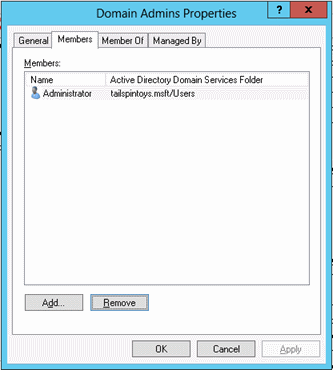
Select a member of the group, click Remove, click Yes, and click OK.
Repeat step 2 until all members of the DA group have been removed.
Step-by-Step Instructions to Secure Domain Admins in Active Directory
In Server Manager, click Tools, and click Group Policy Management.
In the console tree, expand <Forest>\Domains\<Domain>, and then Group Policy Objects (where <Forest> is the name of the forest and <Domain> is the name of the domain where you want to set the Group Policy).
In the console tree, right-click Group Policy Objects, and click New.
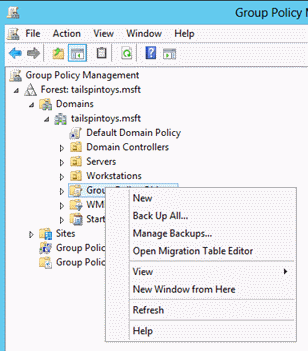
In the New GPO dialog box, type <GPO Name>, and click OK (where <GPO Name> is the name of this GPO).
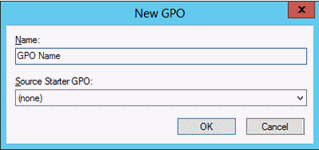
In the details pane, right-click <GPO Name>, and click Edit.
Navigate to Computer Configuration\Policies\Windows Settings\Security Settings\Local Policies, and click User Rights Assignment.
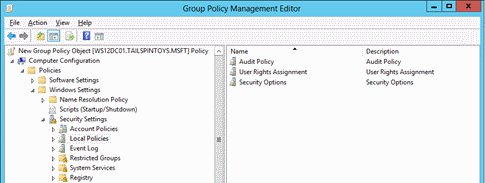
Configure the user rights to prevent members of the Domain Admins group from accessing members servers and workstations over the network by doing the following:
Double-click Deny access to this computer from the network and select Define these policy settings.
Click Add User or Group and click Browse.
Type Domain Admins, click Check Names, and click OK.

Click OK, and OK again.
Configure the user rights to prevent members of the DA group from logging on as a batch job by doing the following:
Double-click Deny log on as a batch job and select Define these policy settings.
Click Add User or Group and click Browse.
Type Domain Admins, click Check Names, and click OK.

Click OK, and OK again.
Configure the user rights to prevent members of the DA group from logging on as a service by doing the following:
Double-click Deny log on as a service and select Define these policy settings.
Click Add User or Group and click Browse.
Type Domain Admins, click Check Names, and click OK.

Click OK, and OK again.
Configure the user rights to prevent members of the Domain Admins group from logging on locally to member servers and workstations by doing the following:
Double-click Deny log on locally and select Define these policy settings.
Click Add User or Group and click Browse.
Type Domain Admins, click Check Names, and click OK.

Click OK, and OK again.
Configure the user rights to prevent members of the Domain Admins group from accessing member servers and workstations via Remote Desktop Services by doing the following:
Double-click Deny log on through Remote Desktop Services and select Define these policy settings.
Click Add User or Group and click Browse.
Type Domain Admins, click Check Names, and click OK.

Click OK, and OK again.
To exit Group Policy Management Editor, click File, and click Exit.
In Group Policy Management, link the GPO to the member server and workstation OUs by doing the following:
Navigate to the <Forest>\Domains\<Domain> (where <Forest> is the name of the forest and <Domain> is the name of the domain where you want to set the Group Policy).
Right-click the OU that the GPO will be applied to and click Link an existing GPO.

Select the GPO that you just created and click OK.
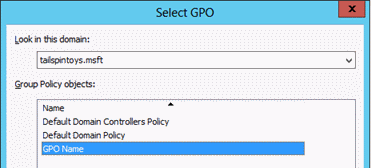
Create links to all other OUs that contain workstations.
Create links to all other OUs that contain member servers.
Important
If jump servers are used to administer domain controllers and Active Directory, ensure that jump servers are located in an OU to which this GPOs is not linked.
Verification Steps
Verify "Deny access to this computer from the network" GPO Settings
From any member server or workstation that is not affected by the GPO changes (such as a "jump server"), attempt to access a member server or workstation over the network that is affected by the GPO changes. To verify the GPO settings, attempt to map the system drive by using the NET USE command.
Log on locally using an account that is a member of the Domain Admins group.
With the mouse, move the pointer into the upper-right or lower-right corner of the screen. When the Charms bar appears, click Search.
In the Search box, type command prompt, right-click Command Prompt, and then click Run as administrator to open an elevated command prompt.
When prompted to approve the elevation, click Yes.

In the Command Prompt window, type net use \\<Server Name>\c$, where <Server Name> is the name of the member server or workstation you're attempting to access over the network.
The following screenshot shows the error message that should appear.
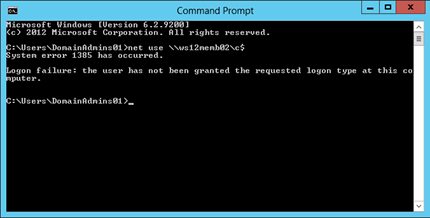
Verify "Deny log on as a batch job" GPO Settings
From any member server or workstation affected by the GPO changes, log on locally.
Create a Batch File
With the mouse, move the pointer into the upper-right or lower-right corner of the screen. When the Charms bar appears, click Search.
In the Search box, type notepad, and click Notepad.
In Notepad, type dir c:.
Click File, and click Save As.
In the File name field, type <Filename>.bat (where <Filename> is the name of the new batch file).
Schedule a Task
With the mouse, move the pointer into the upper-right or lower-right corner of the screen. When the Charms bar appears, click Search.
In the Search box, type task scheduler, and click Task Scheduler.
Note
On computers running Windows 8, in the Search box, type schedule tasks, and click Schedule tasks.
In the Task Scheduler menu bar, click Action, and click Create Task.
In the Create Task dialog box, type <Task Name> (where <Task Name> is the name of the new task).
Click the Actions tab, and click New.
In the Action field, select Start a program.
Under Program/script, click Browse, locate and select the batch file created in the Create a Batch File section, and click Open.
Click OK.
Click the General tab.
Under Security options, click Change User or Group.
Type the name of an account that is a member of the Domain Admins group, click Check Names, and click OK.
Select Run whether the user is logged on or not and select Do not store password. The task will only have access to local computer resources.
Click OK.
A dialog box should appear, requesting user account credentials to run the task.
After entering the credentials, click OK.
A dialog box similar to the following should appear.
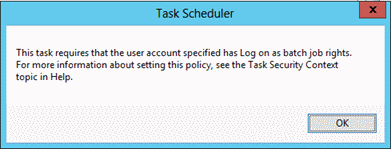
Verify "Deny log on as a service" GPO Settings
From any member server or workstation affected by the GPO changes, log on locally.
With the mouse, move the pointer into the upper-right or lower-right corner of the screen. When the Charms bar appears, click Search.
In the Search box, type services, and click Services.
Locate and double-click Print Spooler.
Click the Log On tab.
Under Log on as, select the This account option.
Click Browse, type the name of an account that is a member of the Domain Admins group, click Check Names, and click OK.
Under Password and Confirm password, type the selected account's password, and click OK.
Click OK three more times.
Right-click Print Spooler and click Restart.
When the service is restarted, a dialog box similar to the following should appear.
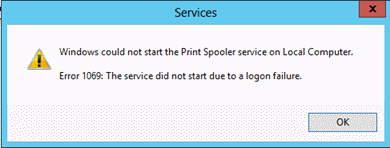
Revert Changes to the Printer Spooler Service
From any member server or workstation affected by the GPO changes, log on locally.
With the mouse, move the pointer into the upper-right or lower-right corner of the screen. When the Charms bar appears, click Search.
In the Search box, type services, and click Services.
Locate and double-click Print Spooler.
Click the Log On tab.
Under Log on as, select the Local System account, and click OK.
Verify "Deny log on locally" GPO Settings
From any member server or workstation affected by the GPO changes, attempt to log on locally using an account that is a member of the Domain Admins group. A dialog box similar to the following should appear.
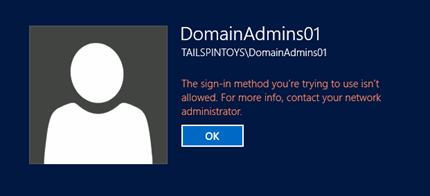
Verify "Deny log on through Remote Desktop Services" GPO Settings
With the mouse, move the pointer into the upper-right or lower-right corner of the screen. When the Charms bar appears, click Search.
In the Search box, type remote desktop connection, and click Remote Desktop Connection.
In the Computer field, type the name of the computer that you want to connect to, and click Connect. (You can also type the IP address instead of the computer name.)
When prompted, provide credentials for an account that is a member of the Domain Admins group.
A dialog box similar to the following should appear.
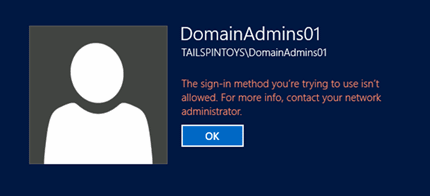
Opinia
Dostępne już wkrótce: W 2024 r. będziemy stopniowo wycofywać zgłoszenia z serwisu GitHub jako mechanizm przesyłania opinii na temat zawartości i zastępować go nowym systemem opinii. Aby uzyskać więcej informacji, sprawdź: https://aka.ms/ContentUserFeedback.
Prześlij i wyświetl opinię dla